A Few Shipboard Aircraft
A few images of shipboard aircraft.
A Fairey Firefly.
An interesting view of a Fairey Firefly. The final version of the Firefly was powered by a Rolls Royce Griffon 74 of 2,245 HP, which gave it a top speed of 386 mph. The pointy things sticking up from the folded wings are the 20mm cannon. | 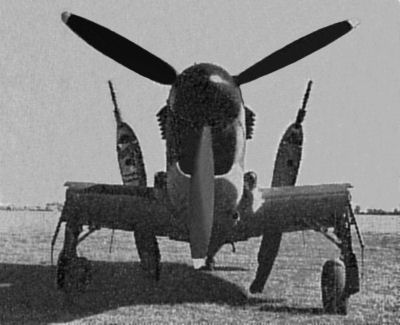 |
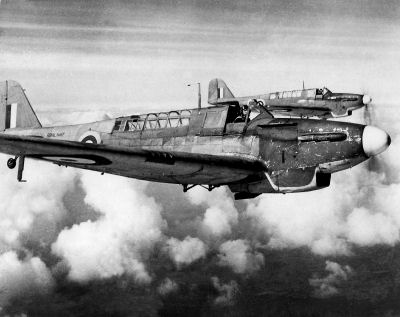 |
A pair of Fairey FulmarsThe Fulmar was the Fleet Air Arm's main shipboard fighter in the early part of the war. It was powered by a Rolls Royce Merlin of 1,300 HP which gave this weighty machine a maximum speed of 272 mph and an range of 780 miles. It was not very popular with its crews, who sang a song about it to the tune of "Any Old Iron". ("Oh you know what you can do, with your Fulmar Mark Two...old iron, old iron.") Their Lordships tried to ban the song - rather unsuccessfully... |
A de Havilland Sea Hornet
This is a DH Sea Hornet prototype. The long arrester hook under the rear half of the fuselage is of note; positioned there for structural reasons; the tail end of the slim wooden fuselage was not built to take a big decelleration load. | 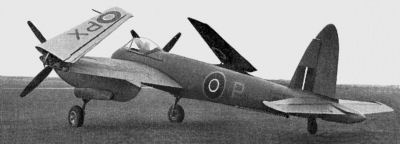 |
The Hornet was powered by two Rolls Royce Merlin 130/131 engines which gave it a top speed of 472 mph. The production Sea Hornet also had a vertical strake on top of the rear fuselage which blended with the forward edge of the fin to provide greater longitudinal stability.
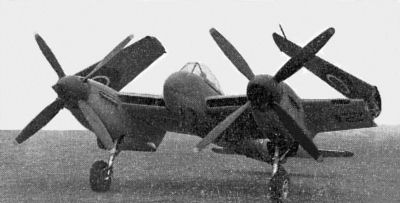 |
Another viewAnother view of the Sea Hornet prototype. |
A Blackburn Firebrand
Wings unfolded ('cos it's flying) a Blackburn Firebrand, the first single-seat torpedo bomber, carries a torpedo with ease. The Firebrand was powered by a Bristol Centaurus engine of 2,520 HP which gave it a top speed of 350 mph. Range was 745 miles. Blackburn went on to produce the marvellous Buccaneer. | 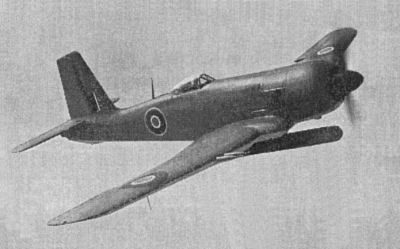 |
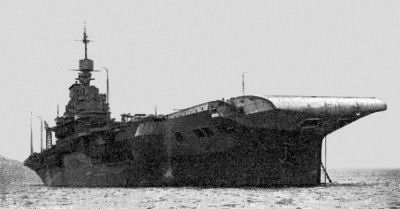 |
HMS IllustriousHMS Illustrious in a quiet moment. Commissioned in May, 1940, Illustrious served in the Mediterranean (causing heavy losses to the Italian navy at Taranto in late 1940), the Indian Ocean, and the Far East. Illustrious was finally scrapped in 1956. |
A Seafire taking off
A Seafire takes off, watched from the island. The Seafire was powered by a Rolls Royce Merlin 55 engine of 1,470 HP and had a top speed of 352 mph. Range on internal fuel was 465 miles. | 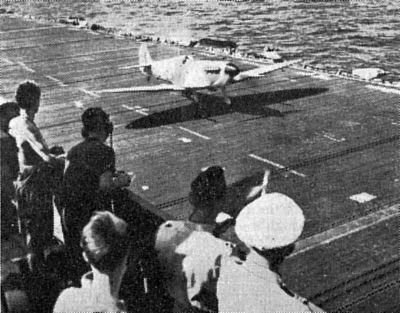 |
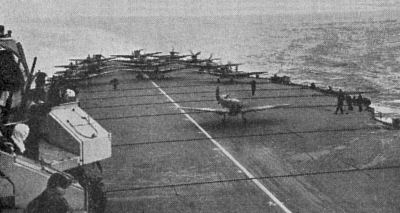 |
Another Seafire takes offAnother Seafire takes off. |
A Sea Fury getting a lift
A Sea Fury emerges for a breath of fresh air on board HMS Illustrious. | 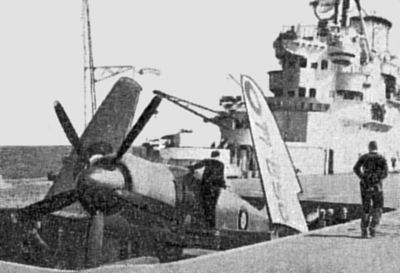 |
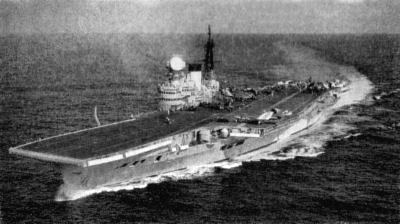 |
HMS VictoriousHMS Victorious in the 1950s. HMS Victorious was laid down 1937 and launched in 1939. Victorious saw against the battleship Bismark, escorted a number of Arctic convoys, and also the famous Pedestal convoy to Malta. Interestingly, Victorious was lent to the USN for a period in 1943 as the USS Robin before being reassigned to the Far East against Japan. |
Victorious underwent a big refit in the 1950s, including the addition of an angled deck, and was finally scrapped in 1969.
Scimitars on board HMS Victorious
Supermarine Scimitars await take-off from HMS Victorious. The Scimitar was powered by a pair of Rolls Royce Avon jets of 11,250 pounds thrust each. These gave a maximum speed of 736 mph and a range of 1,237 nm. Armament was four 30mm ADEN cannon, plus external stores of bombs and missiles. | 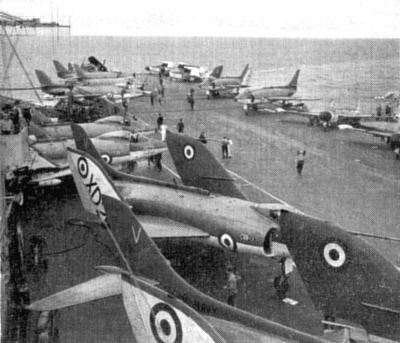 |
 |
A Dragonfly on launch recoveryA Dragonfly helicopter hovers, ready to pick up the crew from a failed launch. A Scimitar and a Sea Venom lurk on the deck in the foreground. The Sea Venom was powered by a de Havilland Ghost turbojet of 4,850 lbs thrust which gave it a maximum speed of 640 mph and a range of 934 nm. Armament was four 20mm Hispano cannon and a variety of bombs and rockets for ground attack. |
A Pair of Helldivers
A pair of Curtis Helldivers. The Helldiver was the replacement for the Dauntless divebomber, and operated from 1943 onwards. Powered by a Wright R-2600 Cyclone engine of 1,900 HP, it had a top speed of 294 mph and a range of 1,200 miles. | 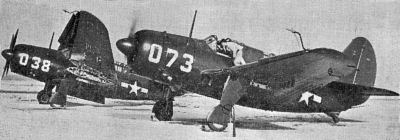 |
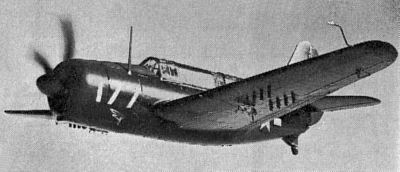 |
An Airborne HelldiverA Helldiver flying. Note the long, curved pitot tube, shaped to avoid position error in dives. |
A Preserved Helldiver
An airworthy Helldiver parked at Harlingen, Texas. | 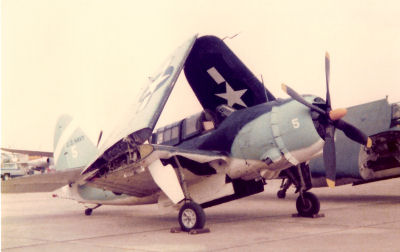 |
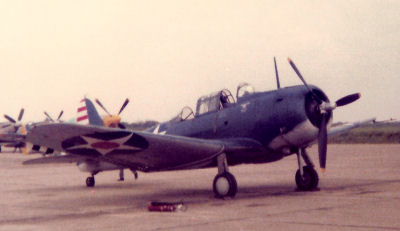 |
A Douglas DauntlessAn airworthy Dauntless parked at Harlingen, Texas. The Dauntless was powered by a Wright R-1820-60 engine of 1,200 HP which gave it a top speed of 255 mph. Range was 773 miles. The Dauntless was operated from 1940 to 1943. |
An Avenger
An airworthy Grumman Avenger parked at Harlingen, Texas. The Avenger was powered by a Wright R-2600-20 engine of 1,900 HP which gave it a top speed of 276 mph. Range was 1,000 miles. The world nearly missed out on Clint Eastwood as actor and director when the Avenger he was hitching a lift in ditched in the sea in the early 1950s. | 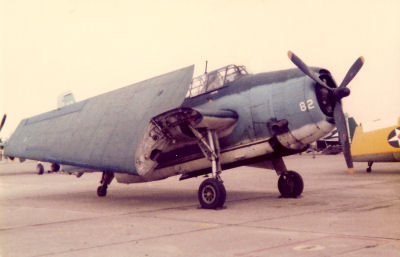 |
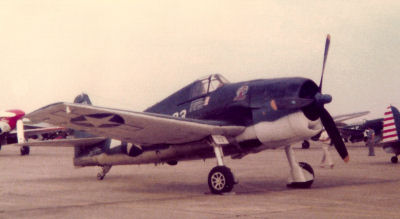 |
A Grumman HellcatAn airworthy Hellcat parked at Harlingen, Texas. The Hellcat, the Wildcat's "bigger brother", was powered by a Pratt and Whitney R-2800 Wasp of 2,000 HP which gave it a top speed of 380 mph. Range was 945 miles. |
An early Corsair
An early model Corsair, parked at Harlingen, Texas. The early Corsair was the first 400 mph fighter built by the US and was powered by a Pratt and Whitney R-2800-8W engine of 2,250 HP, which gave it a top speed of 425 mph. Range was 1,015 miles. | 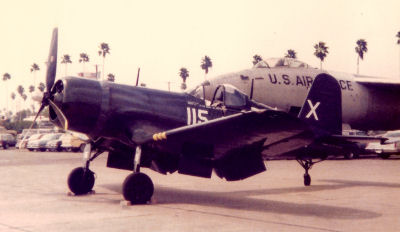 |
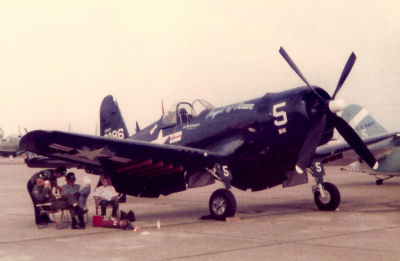 |
A late model CorsairThis is a late model Corsair parked at Harlingen, Texas. This version was powered by a Pratt and Whitney R-2800-18W engine which gave it a top speed of 446 mph. Range was 1,005 miles. |
A Grumman Bearcat
A Grumman Bearcat parked at Harlingen, Texas. The Bearcat just missed service in WWII. It was a departure from the usual Grumman formula, being a very agile lightweight fighter. The Bearcat was powered by a Pratt and Whitney R-2800 Double Wasp engine of 2,100 HP which gave it a top speed of 421 mph. Range was 1,105 miles. | 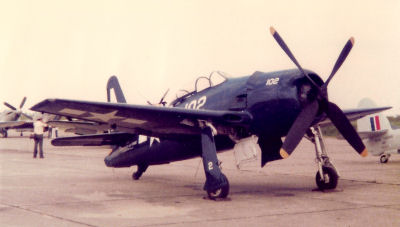 |
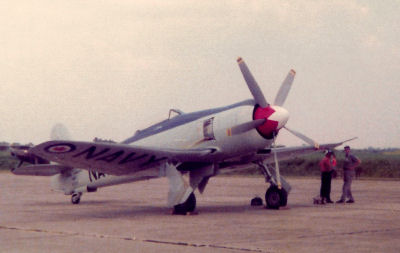 |
A Hawker Sea FuryA Hawker Sea Fury parked at Harlingen, Texas. The Sea Fury was a lightweight development of the Hawker Tempest, and became a very effective shipboard fighter in the late 1940s and early 1950s. The Sea Fury was powered by a Bristol Centaurus engine of 2,400 HP which gave it a top speed of 455 mph. Beefed up Sea Furies have done well at the unlimited races in Reno. |
© Copyright 2007 CairdPublications.com | Site Map | Contact Us |

